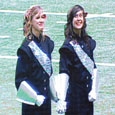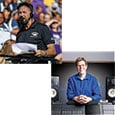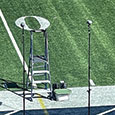Four Texas band directors offer some insight to their band camps, covering topics ranging from student leadership to dance training.
 Playing the Zone
Playing the Zone
Charles Pennington
Allen High School
Last year we created a new student leadership position called Drill Instructor. These band students rank between a section leader and a drum major. We have six for this fall. They are students and members of the marching band who are extremely good at marching and help by teaching marching concepts.
Drill instructors do not worry about music at all; that is the section leaders’ responsibility. Instead, these students are responsible for checking marching basics and drill and cleaning any problems. Drill instructors are star marchers with great posture and fundamental skills, and they know how to fix forms, shapes, curves, and lines and use correct terminology. To keep them from being overwhelmed, drill instructors are assigned to one of six zones. The field is divided into thirds as well as front and back, and each student leader is responsible for the marchers in his zone. By dividing the field into parts, drill instructors can study just their portion of the drill without being responsible for all of it.
The responsibilities extend to posture and instrument carriage, so these students have to know the correct way to hold every instrument because they could be working with trombones and clarinets at the same time. Drill instructors have been a big help because the staff can’t see everything happening on the field at all times. It permits these students to be out on the field and go across sections regardless of what they play, and they can be instructors and helpers for drill. That’s been a great addition.
One good trend that marching bands are following is having an increased emphasis on woodwind players. In the past, the focus was on volume and impact, so brass and percussion seemed to get a disproportionate amount of front billing. In recent years, woodwinds have come to be considered just as important. Modern shows have more balance between all sections of the group. This year our show is Dvorak’s New World Symphony, and we might even use an English horn, in the pit and miked, for the famous solo.
A Section at a Time
Jim Rhodes
Forsan High School
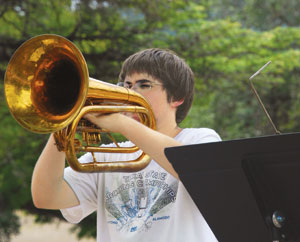
For the first four days of band camp students come in by section. We send out a letter with the schedule for students so they know when they have to be there. From 9-11 a.m. might be flutes and clarinets, then saxophones and horns from 11-1. Once their sectional is over, students are done for the day. By the end of the day we have gotten to drumline and color guard, and we’re through by around 5 p.m. We run sectionals this way for four days, and then on Friday we put it all together to see how it’s going to fit. All students come in for a couple hours, then we tell them we’ll see them on the first day of school.
We teach both music and marching techniques in sectionals. The band hall is big enough that we can move chairs out of the way, put tape down, and make about 30 yards of football field inside, which is preferable to being outside in the summer heat and humidity. When each section arrives, we immediately start going through all the marching fundamentals. After 45 minutes of that I ask students to get their instruments out, and my assistant and I split up the group to work on the show music, fight song, and national anthem. As one sectional ends students are showing up for the next one, and we start again.
I used to take the full band outside for a while to march, then we would come back inside to play. I got a new band hall in 2006 and purposely designed it to be big enough that we could do some marching indoors. This way students don’t have to attend a morning marching rehearsal then return later to play. I ask for two hours of each student’s time, and then they are free to go. Students prefer that. Our school is nine miles out of town, so students have to drive here, or if they can’t drive, their parents or friends have to give them a ride. It’s a big chore to get out here multiple times a day.
I don’t start teaching the show in band camp because I never know who is committed to the band for the year until the first day of school. My drill writer asks me in late May what my numbers will be for next year. If I think I’ll have 18 flutes, I put down 16; if I have 20 trumpets, I’ll put down 18. That gives me a little leeway if a student quits or moves. The numbers are never quite exact, but they’re close. If I’ve charted for 18 trumpets and then have 20 on the first day of school, I use alternates. I assign spots based on who shows up for band camp and is faithful about that. Also, in Texas we have No Pass, No Play, so if I lose a student to that, there is someone available to fill a hole. If I end up with more students than I have spots, I don’t mind putting a trumpet player in a flute spot. If I chart for 16 flutes and end up with 15, I’ll put a clarinet or trumpet player in the last spot. Although it’s ideal for like instruments to march beside each other, there are times when you just can’t get that to happen. Students get sports injuries, and we never know when and where we’ll have holes to fill.
Forsan High School has 204 students, with 130 in the band. Because well over half the high school is in band, there are many students in sports or cheerleading. We work with the coaches to make sure everyone can get students without causing conflicts. We’ve been over 100 in band for as long as I can remember, with strong support from administration and parents. We don’t have as many courses to offer as a large school, but band is one of the great things students can enjoy. I like to have a program that’s well rounded, good in both marching and concert band. We won the state honor band in 2007, which was a big honor for us, and we won the state marching championship that year as well.
Power and Posture
Gregory Dick
Friendswood High School
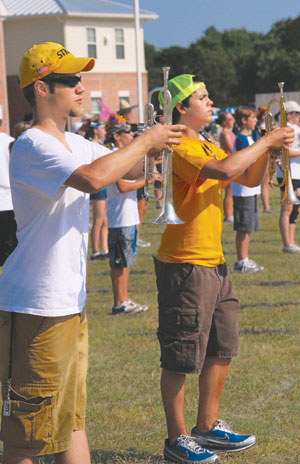
A couple years ago we began working on posture and carriage with a specialist. We work with the volleyball team to schedule some time in the gym. The specialist has students lay down on their backs, with the small of the back touching the ground. While in this position, students perform exercises with the legs and arms while keeping the small of the back touching the ground, which is difficult to do. Students do things like leg and arm lifts. One example has students start by laying on their backs with the arms above the head and the knees bent so the feet are flat on the ground.
Students move their arms toward the floor stretched out above the head while they push their legs out straight, then return to the starting position. When laying flat on the ground you learn how it feels to have everything lined up from head to feet, and many of the exercises begin and end in that position. These exercises strengthen the core and improve balance. The core muscles in the abdomen are important to good posture when standing. When students stand up, their bodies should be in that same position they were in laying down.
If someone were to wander into one of our rehearsals at the right time, he would think this was a ballet class. Quite a bit of dance and ballet instruction is interjected into marching band. The goal in teaching dance elements is to get students to move and look better when they march. It really helps; an uncoordinated adolescent boy practicing dance and ballet quickly gains much better control of his body.
We also plan to work on playing with a more powerful sound and with more dynamic contrast. Judges in the past have suggested we do more of this, so we’re going to emphasize that by changing the drills and warmups that we do with the group. In music rehearsals, we will do more breathing exercises and play warmups at different volumes, especially louder than we usually do. We also want to work on fortepianos and crescendos from piano to fortissimo and back. Later we will do the same exercise while also working on marching fundamentals. Adding varied levels of complexity will force students to pay close attention to their volume as well as how much work they’re doing to project. We want to work on playing loudly, but the correct way, where students stay relaxed and just move the air. When you play loud, you don’t blow air harder, you just use more of it. The air, embouchure, and body have to stay relaxed and calm.
Improve One Thing
Keith Lancaster
Dripping Springs High School

We work with students on the concept of getting better every single day, both musically and visually. Rather than spending much time talking about contests or competition, our philosophy is that at the end of each day, students should be able to name one thing they improved upon. We start that from the first day. Sometimes we go over what students improved as a group, sometimes we do it individually, sometimes we break into sections.
Responses might concern marching basics (“I held my horn up better today.”) or the music (“I held all my phrases out today.”). At the beginning of the day we encourage students to set a goal about one thing they’re going to do better. As we push this, students start paying attention to what they’re doing and try to make themselves better. They also don’t wait for me or some of the other staff to find a fault, they’re constantly trying to figure out what they could do better, so they’re analyzing themselves a lot more.
This year the section leaders are responsible for this as well. We are asking them to question students about what they’re doing better during water breaks to make sure they don’t forget about this halfway through a three-hour rehearsal block. We want to be sure all students stay interested and involved for the entire rehearsal. Band members sometimes become disengaged and bored once they feel they can handle their part fairly well. When the focus is changed to individual improvement on the music and the drill and the marching basics, students stay more engaged.
Section leaders are assigned five to eight students. One of their main responsibilities is making sure that all members of their section are on the field on time. Almost all of our rehearsals are in the morning, and our rehearsal space doubles as the high school student parking lot, so starting on time is essential. The policy is that late students have to run a lap, and the section leader has to run with them. This motivates the section leaders to encourage their charges to be on time and also puts a little pressure on the habitually late student who doesn’t mind running a lap every day in exchange for 10 more minutes of sleep in the morning.
